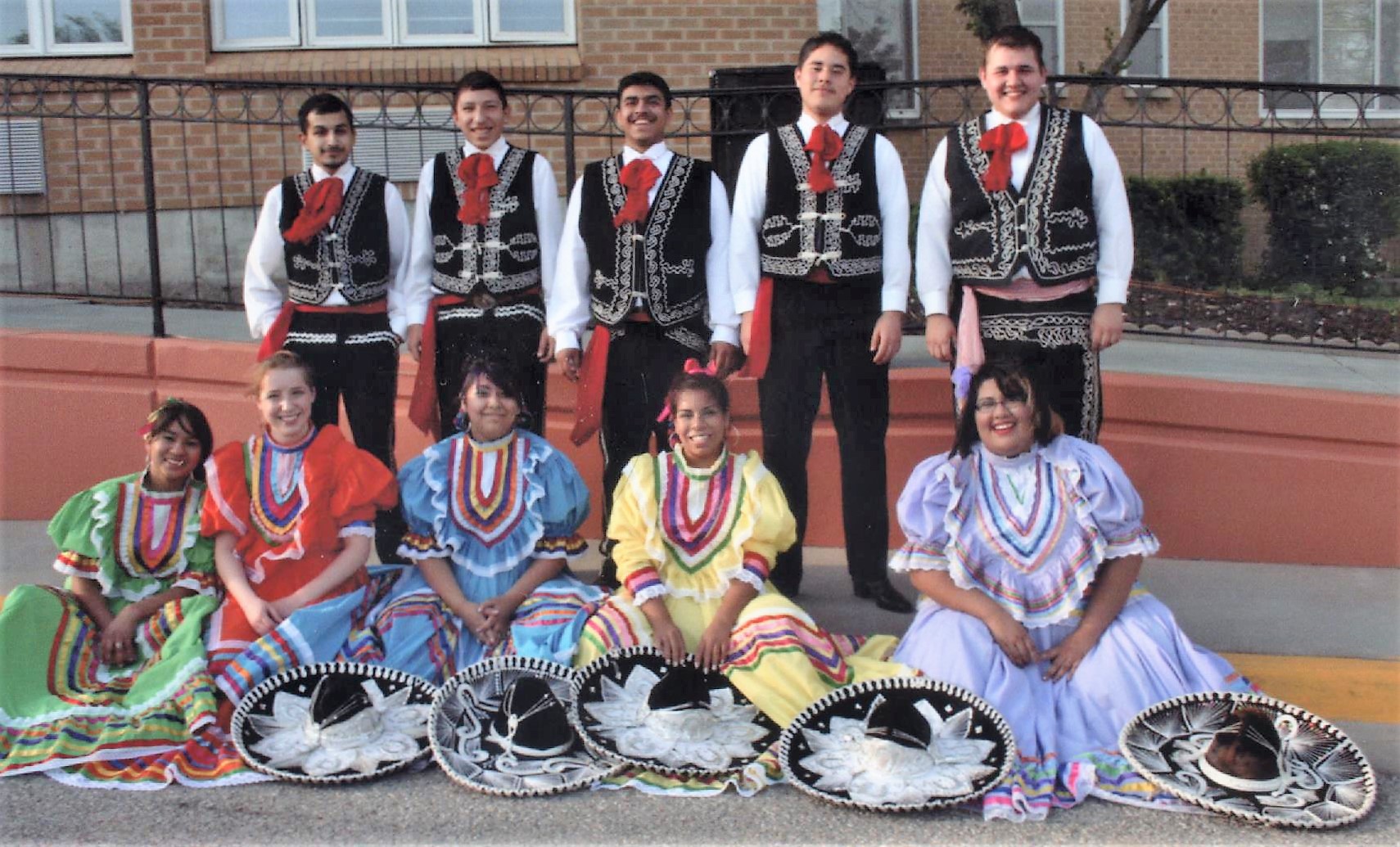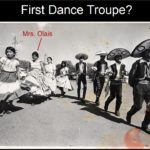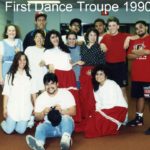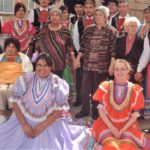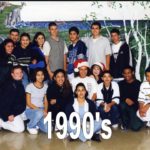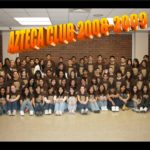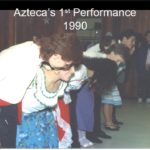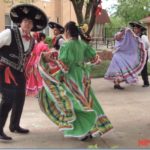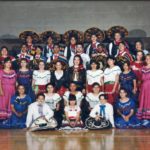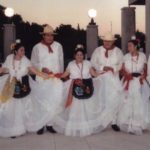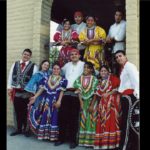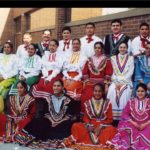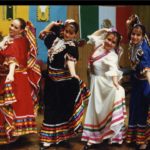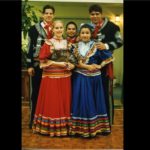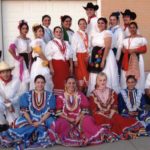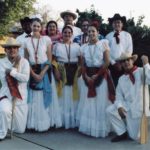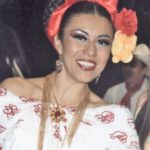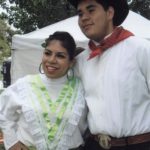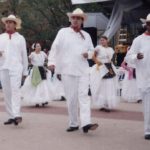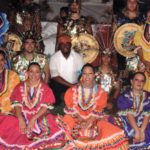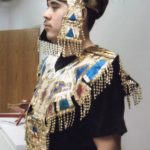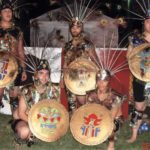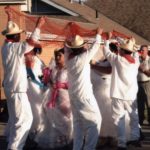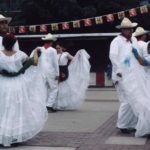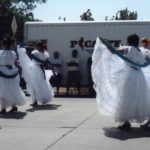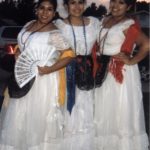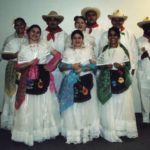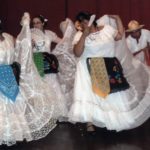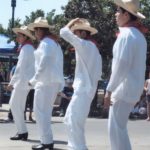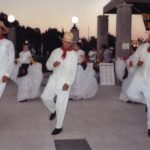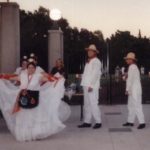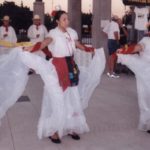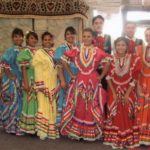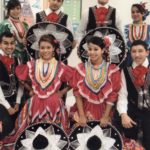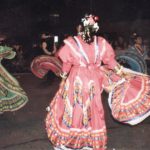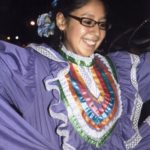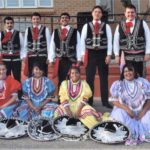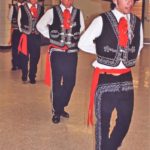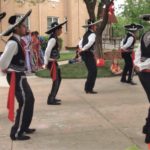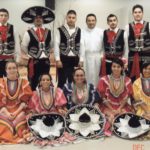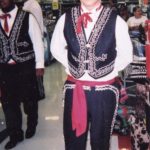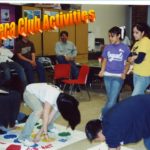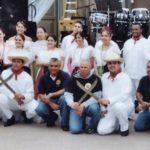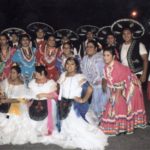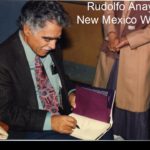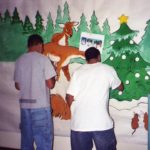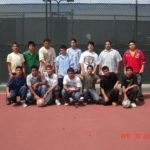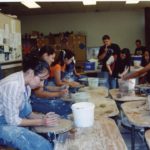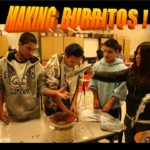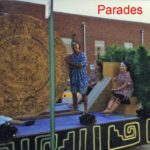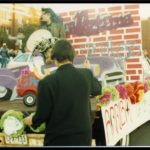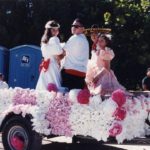Special thanks to Kansas Humanities Council and American Libraries Assn for underwriting this exhibit.
A Living History: the Azteca Club and the Azteca Dancers
Compiled from oral interviews with Patrice Olais and Raymond Olais in December, 2015; Crystal Oster in February, 2016; as well as current and past members of the Azteca Dancers.
The Azteca Club began in 1990 as a special interest club at Newton High School. First called the Spanish Club, the name was changed to Hispanic Club and then to Azteca Club so as to be inclusive of all pre-Hispanic culture, rather than just the Spanish side. The club’s size in the early days was 15 to 20 students with the numbers reaching 100-120 by 2015.
Within the club is a group of about 20 who comprise the Azteca Dance Troupe. The origins of the dance group can be traced to the 1970s, when there were at least two dance troupes from Our Lady of Guadalupe Church in Newton. The Our Lady troupes performed folkloric dances on a routine basis. The church troupes were disbanded in the 1980s, when the fiestas were discontinued in Newton.
The Azteca Club was formed with the goal of broadening cultural experiences. With practices held twice weekly, the dance troupe is a type of living history. As the Azteca Dancers have performed across the state of Kansas–including Wichita, Hutchinson, Emporia, Lawrence, and Chanute–both the dancers and the audience have gained a better understanding of pre-Hispanic traditions and culture.
Click on the first image to scroll through the slideshow.
- Pre-dating the present-day Azteca Dancers, this early dance troupe (from the 1970s?) was from Our Lady of Guadalupe (OLG) Church in Newton. Folkloric dances were performed on a routine basis. Dance troupes from OLG were disbanded in the 1980s when the fiestas were discontinued in Newton. Photo credit: collection of Ray & Patrice Olais.
- Begun as a special interest club at Newton High School, a group was formed with The Spanish Club as its name. The name changed to Hispanic Club and then to Azteca Club so as to be inclusive of all of the pre-Hispanic culture, rather than just the Spanish side. Photo credit: collection of Ray & Patrice Olais.
- The Club’s size in the early days was 15 to 20 students with the numbers reaching 100-120 by 2015. The first dance troupe was formed in 1990. Photo credit: collection of Ray & Patrice Olais.
- What is now known as the Azteca Club and the Azteca Dancers was begun through the efforts of Patrice Olais (who danced in the 1970s with one of the OLG dance troupes), Raymond Olais, Crystal Oster, and many grandmothers and mothers. Photo credit: collection of Ray & Patrice Olais. 2011.
- Azteca Club – members from the 1990s. Photo credit: collection of Ray & Patrice Olais.
- Azteca Club – the 2008-2009 members. Photo credit: collection of Ray & Patrice Olais.
- The origins of the Azteca Dancers can be traced to the 1970s when there were at least two dance troupes from the OLG church in Newton. The Azteca Dancers had their first performance in 1990. Photo credit: collection of Ray & Patrice Olais.
- In contrast to today’s elaborate costumes, the early Azteca Dancers saw the girls attired in the traditional peasant outfit – a plain skirt, a big skirt and a plain white blouse; while the guys wore black pants and a white shirt. Photo credit: collection of Ray & Patrice Olais. 2011.
- For the first Azteca Dancers, funds were limited so costumes were made out of anything — curtains, garage sale fabric, etc. Photo credit: collection of Ray & Patrice Olais.
- With minimal money available in the beginning, community ladies contributed by making outfits for their daughters and granddaughters. The costumes were very basic. From the flag colors, the girls had red skirts, green skirts, and white blouses. The guys wore black pants and white shirts. Photo credit: collection of Ray & Patrice Olais.
- In the early days, the white outfits of the girls in the Azteca Dance troupe were converted lace curtains from local Newton stores. Photo credit: collection of Regina Burke. 2005.
- Volunteers sewed the girls’ bloomers. In addition to needing a wide variety of sizes, they had to be long enough to cover up and regular slips didn’t work. By going to garage sales and second hand stores, a supply of bloomers was made through adjustments, modifications, and added fabric. Photo credit: collection of Ray & Patrice Olais.
- As the dancers received donations from performances, a fund was established so authentic, professional grade outfits could be purchased. Photo credit: collection of Ray & Patrice Olais.
- Costumes purchased by the Azteca Club must stay with the club; and are available for dancers who want to use them. Dancers must buy their own shoes since the shoes need to be in balance. Photo credit: collection of Ray & Patrice Olais.
- Some of the dancers want their own costume so they buy and keep it. Photo credit: collection of Ray & Patrice Olais.
- Any student at Newton High School who has interest can be in Azteca Club. Patrice Olais commented, “They don’t have to be in Spanish classes. They don’t even need to be Hispanic. Over the years, the club has had blonde, blonde girls and guys, African-Americans, and Asians.” Photo credit: collection of Ray & Patrice Olais. 2007.
- There are qualifications for entry into the club; and they can vary some each year. Usually, an in-coming student will be asked to write a paper on an assigned topic. Other times there can be an exam. Often there are additional requirements. Successful completion of the qualifications places a student on the Azteca Club roster for that year. Photo credit: collection of Ray & Patrice Olais.
- Within the Azteca Dancers, most—but not all—of the troupe are part of the Azteca Club. Because of other interests and activities which meet at the same time as the Azteca Club, a student can perform if they’ve put in at least one year with the Azteca Club and participate in practices of the dance troupe. Photo credit: collection of Ray & Patrice Olais.
- Sometimes participants at Azteca Dance performances have graduated from high school since the troupe is open to the community. Up through twenty-three years of age, an individual can either dance with the troupe or help with performances. These individuals are valuable since they know the dances. They give consistency, provide maturity, and help to mentor the younger ones. An individual who comes back after twenty-three must be a teacher. Photo credit: collection of Ray & Patrice Olais.
- Members of the Azteca Dancers learn life skills. They learn to be responsible for their clothing and time schedules, and how to work as a team when performing. The dancers must make sure everyone looks good and works together. Photo credit: collection of Ray & Patrice Olais. 2012.
- Because there can be subtle changes in costuming and dance steps among the multitude of regions, the Azteca Dancers focus on the major ones. As a result, there can be five different costume changes when the troupe performs. Photo credit: collection of Regina Burke. 2006.
- The style of the troupe is traditional folkloric dancing—traditional Mexican dancing. Within this broad category, each region of Mexico has a different style, different music, different costumes, and different dances. This project focused on four dances: Aztec, Veracruz, Jalisco, and Jarabe Tapatio (Mexican Hat Dance). Photo credit: collection of Ray & Patrice Olais.
- Dances of the Aztec people are the oldest ones performed by the Azteca Dance troupe. Photo credit: collection of Ray & Patrice Olais. 2011.
- About 800 years ago, a wandering tribe called the Aztecs entered the high plateau valley of the land we now call Mexico. They rose to become the strongest people in the valley. They called their land “Anahuac” or “The Land between the Waters” and ruled from their city, Tenochtitlan. Photo credit: collection of Ray & Patrice Olais.
- Aztec dancers hold maracas in the hands and seed pods on the ankle make sound. Photo credit: collection of Ray & Patrice Olais. 2011.
- Feathers are used in Aztec head wear. Photo credit: collection of Ray & Patrice Olais. 2011.
- Veracuz dances come from the east coast of Mexico. Photo credit: collection of Ray & Patrice Olais. 2007.
- The portal city of Veracruz influenced the customary white costume. Photo credit: collection of Ray & Patrice Olais.
- The Veracruz costume has a full lace skirt which was borrowed from the Spanish. Photo credit: collection of Ray & Patrice Olais. 2012.
- The fan of the Veracuz costume reflects Spanish influence. Photo credit: collection of Ray & Patrice Olais.
- An embroidered black apron reflects a Chinese influence. Photo credit: collection of Ray & Patrice Olais.
- Rebozos (shawls) and flowers can be any color. Photo credit: collection of Ray & Patrice Olais.
- Performing a Veracruz style dance. Photo credit: collection of Ray & Patrice Olais. 2012.
- Dressed in the Veracruz type costume. Photo credit: collection of Regina Burke. 2005.
- Performing a Veracruz style dance. Photo credit: collection of Regina Burke. 2005.
- Performing a Veracruz style dance. Photo credit: collection of Regina Burke. 2005.
- Performing a Veracruz style dance. Photo credit: collection of Regina Burke. 2005.
- Jalisco dances came from the state of Jalisco which is located in the middle region of Mexico. Photo credit: collection of Ray & Patrice Olais.
- The Jalisco dress is a circle and a half of a full ribboned dress. Photo credit: collection of Ray & Patrice Olais.
- The Jalisco dress has 15 yards of ribbon. Photo credit: collection of Ray & Patrice Olais. 2011.
- The Jalisco dress has a Victorian collar. Photo credit: collection of Ray & Patrice Olais.
- The dresses are worn on a horse in “charro” fashion. Photo credit: collection of Ray & Patrice Olais.
- In Jalisco dancing, the charro outfit for the guy has embroidery on the vest, jacket, and sombrero. Photo credit: collection of Ray & Patrice Olais.
- Jalisco dancing. Photo credit: collection of Ray & Patrice Olais. 2011.
- The Jarabe Tapatio dance (The Mexican Hat Dance) comes from the state of Jalisco. Tapatio is applied to anything from that state. The name distinguishes it from all the other jarabes. Jarabe means a syrup or sweet drink in Spanish. Photo credit: collection of Ray & Patrice Olais. 2011.
- The Mexican Hat Dance was developed around 1920 in Guadalajara in the state of Jalisco and is considered the national folk dance of Mexico. Photo credit: collection of Regina Burke. 2005.
- The Jarabe Tapatio dance (The Mexican Hat Dance) is traditionally presented as the last dance of any performance. It is a dance of courtship. Photo credit: collection of Regina Burke. 2005.
- Azteca Club members are able to participate in a variety of activities and field trips. Photo credit: collection of Ray & Patrice Olais.
- The Azteca Club has speakers, activities, and field trips. The dance troupe learns the various dances and then performs at festivals, fiestas, celebrations, weddings, and special events. Monies earned from the performances are used to pay for the costumes. Photo credit: collection of Ray & Patrice Olais.
- As one of the co-sponsors, Raymond Olais teaches culture and heritage. Patrice Olais, the second co-sponsor, works with the dance troupe. Patrice and Ray said, “The club is geared towards culture and learning about their culture even if they do not dance.” Photo credit: collection of Ray & Patrice Olais.
- Periodically, outside speakers make presentations on culture and heritage. At times, the presenter has been a maestro, a master dancer from Mexico. Photo credit: collection of Ray & Patrice Olais.
- Rudolfo Anaya, a writer from New Mexico, gave his perspective on culture and heritage. Photo credit: collection of Ray & Patrice Olais.
- Using and developing art skills to create decorations for an activity. Photo credit: collection of Ray & Patrice Olais.
- Gathered for a sports outing. Photo credit: collection of Ray & Patrice Olais.
- Developing and using artistic abilities. Photo credit: collection of Ray & Patrice Olais.
- Developing cooking skills while learning culture during a tortilla rolling contest. Photo credit: collection of Ray & Patrice Olais.
- Do they have futures as cooks? Photo credit: collection of Ray & Patrice Olais.
- Learning how to make burritos… Photo credit: collection of Ray & Patrice Olais.
- …serves a dual purpose of learning culture as well as fundraising. Photo credit: collection of Ray & Patrice Olais.
- The Azteca Club enjoys a disco nite. Photo credit: collection of Ray & Patrice Olais.
- Another evening of dancing for Azteca Club members. Photo credit: collection of Ray & Patrice Olais.
- Over the years, the Azteca Club has been involved in community events and parades. Photo credit: collection of Ray & Patrice Olais.
- The Azteca Club participates in community parades. Photo credit: collection of Ray & Patrice Olais.
- Wearing their costumes, the Azteca Dancers participate in a parade. Photo credit: collection of Ray & Patrice Olais.
- The Azteca Club is promoted by using a float in a community parade. Photo credit: collection of Ray & Patrice Olais.
- Several members represent the Azteca Club. Photo credit: collection of Ray & Patrice Olais.
- Since the 1970s, The Azteca Club and its predecessors have been involved in preserving and presenting important traditional dances; and, in doing so, Mexican American culture. The Story of the Azteca Club and Azteca Dancers was compiled from oral interviews with Patrice Olais and Raymond Olais (December, 2015), Crystal Oster (February, 2016), and current and past members of the Azteca Dancers; plus, through the efforts of Deb Hiebert and Ronald Dietzel of the Harvey Co Historical Museum. Funding was provided by the Kansas Humanities Council and the American Libraries Association.
Interview with Nicole Bornowsky:
Interview with Crystal Oster:
Interview with Patrice and Ray Olais part 1:
Interview with Patrice and Ray Olais part 2:

